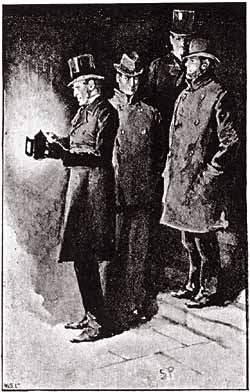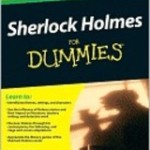A Scion Society of The Baker Street Irregulars

Data! Data! Data! – The Red-Headed League
“‘Data! Data! Data!‘ he cried impatiently. ‘I can’t make bricks without clay.’”
– The Adventures of The Copper Beeches (COPP)

This column is composed of material (Data!) developed for a short course called Appreciating Sherlock Holmes that I teach twice a year in the Community Education Life Enrichment Program for a local community college. It is composed of “points of information” that are common to many / most / all of the 60 Canonical stories.
The information here has been researched by me or borrowed / stolen from many efforts of other Sherlockians.
Let’s start with a limerick from an eminent Sherlockian, named Isaac Asimov, that is a great summary of this month’s story.
Jabez Wilson, a red-head, grew needier
So he copied the encyclopedia
More for money than fun,
Till a tunnel is done.
Crooks worked quickly, but Sherlock was speedier.
HERE GOES This month’s story The Red-Headed League
 CHRISTOPHER MORLEY SAID
CHRISTOPHER MORLEY SAID
A red-headed pawnbroker spends eight weeks copying the Encylopaedia Britannica with a quill pen, but in the meantime what was his assistant doing in the cellar? This was a “three-pipe problem,” but the knees on a pair of trousers gave Holmes the clue.
DUMMIES SHORT SUMMARY (From Sherlock Holmes for Dummies by Steven Doyle & David Crowder)
“This story begins with high comedy but ends with a dangerous vigil in a darkened bank vault full of French gold.”
PUBLISHING HISTORY
- This is the 4th of the 60 stories published.
- In England, it was published in The Strand Magazine in August, 1891.
- It was part of The Adventures of Sherlock Holmes collection published by George Newnes, Ltd., London, 1892, and by Harper Bros., New York, 1892
- The British illustrator was Sidney Paget
HOW MANY WORDS?
According to C. E. Lauderback, 1960 – – found on SHERLOCKIAN.NET website started by Chris Redmond, REDH, at 8,189 words REDH has the 33rd most words (#1 is VEIL – 4,499, #56 if NAVL – 12,701)
THE BEST OF SHERLOCK HOLMES (How do Sherlockians rate this story?)
This month’s tale is almost at the top of everyone’s favorites list.
1927 – Arthur Conan Doyle had it as #2 on the list of his 12 favorite stories
1944 – The Baker Street Irregulars voted it as #3 on their top 12 favorites
1999 – The Baker Street Irregulars voted it as #2 of the 56 short stories
1999 – Sherlock Holmes Society of London – 2 of 56
CLASSIFYING THE CASE (From the Wandering Gipsies of Grimpen Mire of Decatur, Alabama)
This case is one of 3 classified as a theft of money. The others were STOC, and 3GAR.
CHRONOLOGICALLY SPEAKING
Doyle was often very vague about stating WHEN the tale took place and included few contemporary references to help. Whether this was done intentionally or unthinkingly, the dating of events in the Canon is a very popular pastime pursued by several of our “scholars” researching and justifying their results to no end. We will again default to William Baring-Gould’s dating of Saturday, October 29 to Sunday, October 30, 1887, making it the 13th of the 60 stories in time. This means that Holmes is 33 and Watson 35.
WHAT ELSE HAPPENED IN 1887?
It is always interesting to see what else in happening at the same time as the stories.
- British East Africa Company charter awarded.
- Zululand becomes protectorate.

- Victoria’s Golden Jubilee, end of Windsor Retirement.
- Britain annexes Zululand.
- Irish Coercion Act; Irish Land Act.
- Charing Cross Road opens.
- Coal Mines Regulation Act, boys under 13 not to work underground, and under 12 at the surface.
- United States begins free mail delivery to homes of any community with a population of 10,000 or more.
- China recognizes Portugal’s right to the island of Macao.
- Renewal of Russo-German ‘Reinsurance’ Treaty; and Triple Alliance
- Italian force annihilated by Ethiopians at Dogali; designs on Tripoli conditionally supported by Britain and Germany.
- Union of Indo-China formed by France.
- Macao recognized as Portuguese by China.
- Yellow River floods in China, killing nearly a million people.
- Interstate Commerce Act, federal control of interstate railways.
- Conan Doyle’s A Study in Scarlet, first Sherlock Holmes story, published.
- Rider Haggard publishes She and Allan Quatermain.
- Cazanne paints The Blue Vase.
- Claude A. Debussy debuts Le Printemps.
- Monet paints Fields in Spring.
- Verdi debuts Othello.
- Radio waves discovered by Hertz.
- Bauxite, source of aluminum, is discovered in Georgia.
- Edison and Swan combine to produce ‘Ediswan’ electric lamps for domestic use
- Mach defines the Mach Number, now used in supersonic flight.
- Daimler four-wheeled motor car produced.
HOLMES AND WATSON – PERSONAL INFO
Watson not living with Holmes at 221B, but is residing with his wife at his house in Kensington.
DRAMATIS PERSONAE
Both Wilson and Clay are high on the list of memorable characters in the Canon.

- JABEZ WILSON, a pawnbroker with flaming red hair.
- JOHN CLAY aka VINCENT SPAULDING, murderer, thief, smasher, and forger. A brilliant criminal, he has attended Eaton and Oxford and his grandfather was a Royal Duke.
- DUNCAN ROSS aka WILLIAM MORRIS, confederate of Clay and director (?) of the Red-headed League.
- EZEKIAH HOPKINS, fictional millionaire created by Clay who supposedly founded the Red-headed League.
- PETER JONES, official police agent.
- MERRIWEATHER, bank official
“QUOTABLE SHERLOCK”
- Holmes to Watson inviting him in on a case – – “I know, my dear Watson, that you share my love of all that is bizarre and outside the conventions and humdrum routine of everyday life. You have shown your relish for it by the enthusiasm which has prompted you to chronicle, and, if you will excuse my saying so, somewhat to embellish so many of my own little adventures.”
- Holmes’ comment to Watson on life/crime – – “For strange effects and the extraordinary combination we must go to life itself, which is always far more daring than any effort of the imagination.”
- Holmes to Watson on the case before them – – “As a rule, when I have heard some slight indication of the course of events, I am able to guide myself by the thousands of other similar cases which occur to my memory. In the present instance I am forced to admit that the facts are, to the best of my belief, unique.”
- Holmes to Watson about Jabez Wilson who just came in – – “Beyond the obvious facts that he has at some time done manual labour, that he takes snuff, that he is a Freemason, that he has been in China, and that he has done a considerable amount of writing lately, I can deduce nothing else.”
- Holmes to Watson about the case – – “As a rule,” said Holmes, “the more bizarre a thing is the less mysterious it proves to be. It is your commonplace, featureless crimes which are really puzzling, just as a commonplace face is the most difficult to identify.”
- Holmes to Watson about the case – – “It is quite a three-pipe problem . . . “
- Holmes to Watson on the, as yet, not named John Clay – – “He is in my judgment, the fourth smartest man in London, and for daring I am not sure that he has not a claim to be the third.”
- Holmes to Watson in deducing the case – – “We are spies in an enemy’s country.”
- Holmes to Watson about working the case – – “It is a hobby of mine to have an exact knowledge of London.”
- Holmes to Watson when he has come up with the solution – – “And now, Doctor, we’ve done our work, so it’s time we had some play. A sandwich and a cup of coffee, and then off to violin-land, where all is sweetness and delicacy and harmony, and there are no red-headed clients to vex us with their conundrums.”
- Holmes to Watson about solving the case – – “There may be some little danger, so kindly put your army revolver in your pocket.”
- Holmes to Watson explaining a clue – – “I hardly looked at his face. His knees were what I wished to see.”
- Holmes to Watson on his “philosophy” – – “My life is spent in one long effort to escape from the commonplaces of existence. These little problems help me to do so.”
HOLMES’ FEE
Holmes prevented the loss of £30,000, but when the bank-director offered to pay Holmes, the reply was, “I have been at some small expense over this matter, which I shall expect the bank to refund, but beyond that I am amply repaid by having had an experience which is in many ways unique, and by hearing the very remarkable narrative of the Red-headed League.”
SHERLOCK ON THE BIG SCREEN & THE LITTLE SCREEN
As one of the most popular stories, REDH has been on the screen several times
- 1921 The Red-Headed League with Eille Norwood as the 5th of his 47 short movies
- 1954 The Case of the Red Headed League on TV with Ronald Howard in his 39 episode series
- 1965 The Red-Headed League with Douglas Wilmer in the BBC-TV 13 episode Sherlock Holmes series
- 1967 Die Liga der Rothaarigen with Eric Schellow as part of a 6 episode German TV series
- 1985 The Red Headed League with Jeremy Brett in the BBC/Granada Sherlock Holmes series
- 2000 The Red-Headed League as an episode of the Sherlock Holmes in the 22nd Century animated series
SHERLOCK HOLMES IN DISGUISE
The Master of disguise used the deception of being disguised 14 times in 11 of the 60 stories, but none were needed in this tale.
UNRECORDED CASES (That involved Holmes)
Watson would tease / torture his readers with “I know something you don’t.” Oh my, how Sherlockians love this category. I have in excess of over 150 examples in my collection of the 80 +/-stories referenced but not told in the Canon.
FAINTING IN THE CANON (courtesy of Sherlockian Karen Murdock)
Fainting is extremely common in the Canon, appearing, in some form, in 37 of the 60 tales. In 21 cases someone actually faints. In 22 cases someone almost faints. And in 5 cases someone pretends to faint. In this month’s story, no one hits the floor.
HOLMES’S PUBLISHED & PROJECTED WORKS
Sherlockians love this topic and are regularly searching for these items. Holmes mentions published or projected works in 11 of the stories but none are mentioned in this story.
IS THERE A DOCTOR IN THE HOUSE?
Victorian London, in the Holmes’ time, had approximately 1 doctor for every 100 people. 31 of the 60 tales have a doctor in them. This, of course, does not count Holmes’ Boswell. This listing is by Leslie Klinger in the Winter, 2015 edition of the Baker Street Journal. Whether it was Doyle or Watson, a doctor wrote the story. In this story, there was no doctor involved or mentioned.
NEWSPAPERS (Real and Fictional)
Though included in only 20 tales some of our more obsessed Sherlockians love this one.
- Daily Chronicle – A morning paper established in 1877. Liberal and one of the most popular.
- Morning Chronicle – One of the more esteemed papers started in 1769. Was touted for its journalistic and literary integrity. Entered bankruptcy in 1862.
ANNOTATED SHERLOCK
The 60 Sherlock Holmes stories used English as spoken in England from the 1880’s until the 1910’s. Some words are foreign to us today and need a “contemporary translation”. For this tale, several people found words in this category. Some examples:
- “Omne ignotum pro magnifico” – Latin translated as “Everything unknown passes for something splendid.” From Tacitus. This is only time Holmes every used a full quote from a Roman author.
- “off you go at scratch” – The line from which contestants start a race. Holmes is saying “begin at the beginning.
- “a coster’s” – Short for costermonger: an apple seller; a hawker of fruit or vegetables from a street stand, barrow, or cart.
- “press” – A copy of the E.B. was kept in one. An upright case or cupboard for the keeping of articles.
- “foolscap” – paper in sheet measuring 13 by 16 or 17 inched – so called – because the watermark of a fool’s cap and bells was used by old papermakers.
- “a solicitor” – One who represents a client in a court of justice; an attorney; formerly in England, a practitioner in chancery only. In England solicitors prepare cases for barristers but have not the right to appear as advocates before the higher courts
- “a partie carrée” – French for a “square party” or party of four, usually 2 men and 2 women
- “the derbies” – slang for hand-cuffs
- “a deal table” – a board of sawn fir or pine.
- “billet” – slang term for a job.
- “smasher” – John Clay was also one who passes bad coins or forged notes.
- ”L’homme c’est rien-l’oeuvre c’est tout” – Correctly “L’homme n’est rien, l’oeuvre tout” “The Man is nothing, the work is everything.”
- “L’homme c’est rien–l’oeuvre c’est tout” – “The man is nothing–the work is all” (French).
- “omne ignotum pro magnifico” – “The more unknown, the more magnificent” (Latin). Holmes uses Latin because he and Watson, as educated middle-class men, would know it but the working-class Wilson would not.
- “Napoleon” – a 20 franc French coin, so called because they carried a likeness of either Napoleon Bonaparte or Napoleon III.
- “Sovereigns” – coins worth one pound sterling, so called because they carried a likenesses of English kings and
- “artificial knee-caps” – This was what we now call a “knee-pad”.
WEAPONS (from A Compendium of Canonical Weaponry by Dettman and Bedford)
… “a means by which one contends against another” … utilized in 57 of the 60 tales (all but CREE, 3STU, & YELL) … There are several general categories to classify “weapons” that include: firearms, human agents, cutlery, animals, blunt instruments, extortion, toxin, blackmail, and miscellaneous. In our story, which is short, you will find the following:
- Revolver – John Clay (alias Vincent Spaulding) had with him while breaking into the Coburg branch of the City and Suburban Bank, and which Holmes knocked out of his hand.
- Service Revolver – Dr. Watson’s and is mentioned in 13 cases.
- Heavy Hunting Crop – Of Sherlock Holmes, used to knock the gun out of John Clay’s hand.
ODD STUFF
Sherlock Holmes authority Leslie Klinger, in the Annotated Sherlock Holmes, tells us that on January 20th, 1920, the Stoll Film Company (filming the Eille Norwood Sherlock Holmes series) placed this ad in the Times:
“‘On account of circumstances not unconnected with the bequest of the late Hezekiah [sic] Hopkins of Lebanon, Penn. USA, lucrative employment for One Day Only is now available for twenty CURLY, RED-HEADED MEN who are sound in mind and body. Those who have served in HM Forces and have some knowledge of acting preferred.’ Forty curly, red-haired ex-servicemen applied to the Cricklewood Studio and the producer decided to engage them all.” (Klinger, Vol. 1, p.45)
 Frank Mentzel, aka Merridew of Abominable Memory, has begun to prep for his next series of classes that begin in October and is still planning on what holiday cookies he will be baking later this year.
Frank Mentzel, aka Merridew of Abominable Memory, has begun to prep for his next series of classes that begin in October and is still planning on what holiday cookies he will be baking later this year.

Sorry, comments are closed for this post.